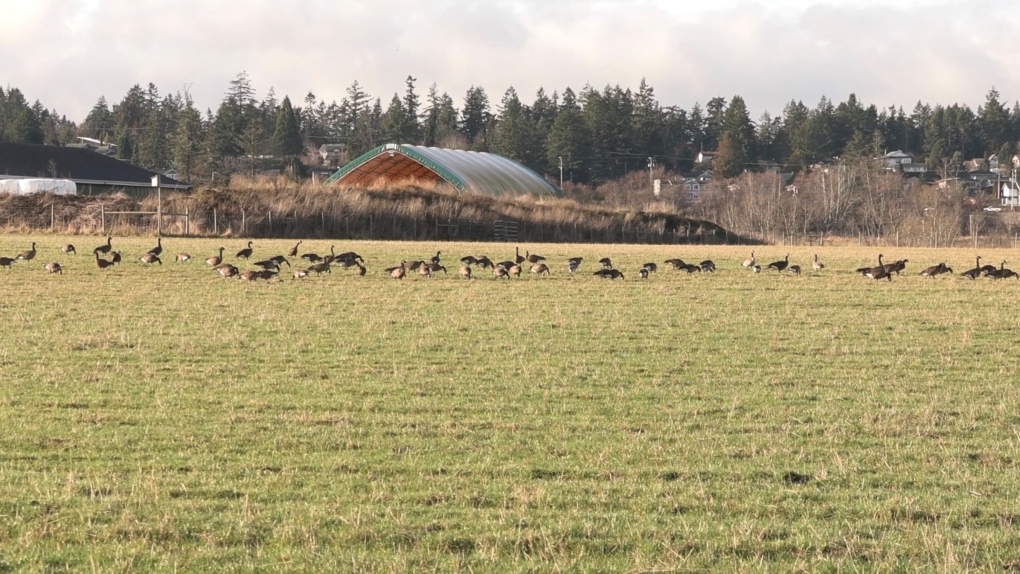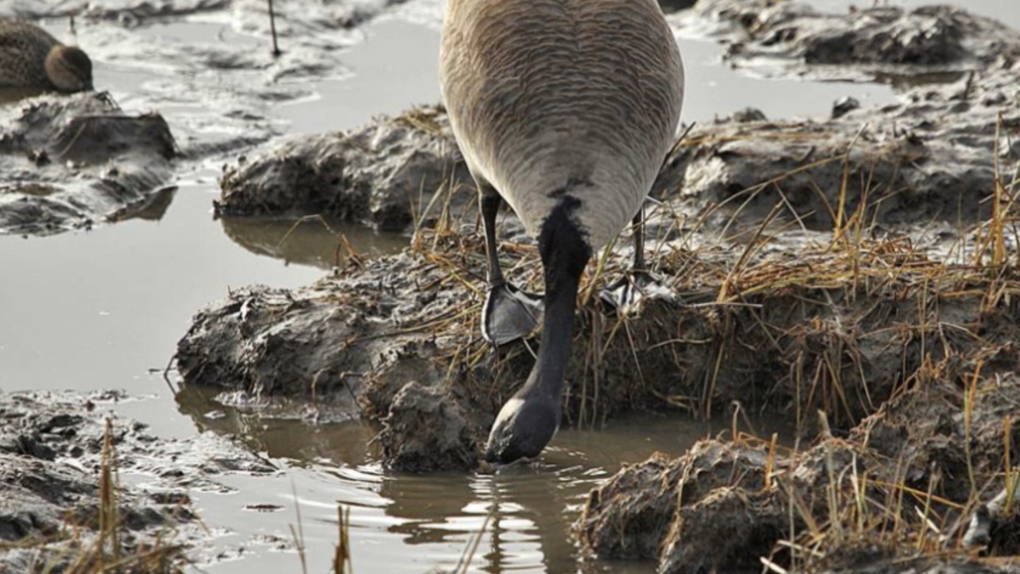CRD's proposed goose cull receives support from farmers, bird advocates
Ask farmers on Vancouver Island and many will tell you, geese are their biggest problem.
"It’s just devastating," said Terry Michell, owner of Michell’s Farm in Central Saanich, B.C.
 A gaggle of geese are pictured in a farmer's field in Central Saanich, B.C. Jan. 10, 2023. (CTV News)
A gaggle of geese are pictured in a farmer's field in Central Saanich, B.C. Jan. 10, 2023. (CTV News)
An example of the problem could be seen at a farmer's field near Michell’s Farm on Tuesday, where a gaggle of geese were eating everything in sight.
"Some crops, we’ve lost 100 per cent of some fields, and some we’ve lost 30 per cent," said Michell.
The Canada goose population in the region is estimated to be 10,000 to 15,000 birds, some 3,500 to 7,000 of them overwintering in the area. It’s a population that doubles every four years.
The Capital Regional District (CRD) is now proposing a "Canada Goose Management Strategy."
"That would involve culling of animals as well as egg addling," said Colin Plant, Capital Regional District board chair.
Addling means killing the embryo inside a fertile goose egg.
The management strategy will go ahead provided 10 per cent of eligible voters in the CRD, or approximately 35,000 people, do not voice opposition to the plan by the cutoff date of Jan. 23.
IMPACTS ON ECOSYSTEMS
The CRD, as well as some wildlife advocates, say the geese are causing problems for local birds.
"This is a human-created problem and, very reluctantly, I support the steps to reduce this problem," said Ann Nightingale, board member at Rocky Point Bird Observatory in Victoria.
Nightingale, who is a bird advocate, says before the 1970s, on average, 125 geese were counted during the annual Christmas Bird Count. Those birds also would have been migratory.
"So the population has really taken off," said Nightingale. "These birds are very destructive in native habitats, in estuaries where native birds need those habitats."
Tim Clermont, executive director of the Guardians Of Our Salish Sea Estuaries, says the geese can also impact other types of wildlife.
"We’re seeing a 90 per cent loss of Carex lyngbyei sedge, which is an important marsh plant that helps productivity of estuaries," said Clermont,
 A goose is pictured in a Vancouver Island estuary eating Carex lyngbyei sedge, a plant that is essential for juvenile salmon and marsh health. (CTV News)That plant is critical habitat for juvenile salmon and without it marshes can’t function, he says.
A goose is pictured in a Vancouver Island estuary eating Carex lyngbyei sedge, a plant that is essential for juvenile salmon and marsh health. (CTV News)That plant is critical habitat for juvenile salmon and without it marshes can’t function, he says.
"If you don’t have intact marshes you lose your shorelines, you lose your habitat for salmon," said Clermont.
The meat harvested from the Goose Management Strategy will be turned over to the CRD’s First Nation partners for consumption.
The CRD says it’s unclear what the expected reduction in the goose population will be, when and if the plan goes into effect.
CTVNews.ca Top Stories

Biden gives life in prison to 37 of 40 federal death row inmates so Trump can't have them executed
U.S. President Joe Biden announced on Monday that he is commuting the sentences of 37 of the 40 people on federal death row, converting their punishments to life imprisonment just weeks before president-elect Donald Trump, an outspoken proponent of expanding capital punishment, takes office.
Weather advisories issued for GTA, areas north of Toronto ahead of 'significant' snowfall
Holiday travellers and commuters could be in for a messy drive on Monday morning as a significant round of snowfall moves into the region.
Nissan, Honda announce plans to merge, creating world's No. 3 automaker
Japanese automakers Honda and Nissan have announced plans to work toward a merger, forming the world's third-largest automaker by sales as the industry undergoes dramatic changes in its transition away from fossil fuels.
Trump suggests the U.S. should take back the Panama Canal. Could they do that?
Donald Trump suggested Sunday that his new administration could try to regain control of the Panama Canal that the United States 'foolishly' ceded to its Central American ally, contending that shippers are charged 'ridiculous' fees to pass through the vital transportation channel linking the Atlantic and Pacific Oceans.
Man handed 5th distracted driving charge for using cellphone on Hwy. 417 in Ottawa
An Ottawa driver was charged for using a cellphone behind the wheel on Sunday, the fifth time he has faced distracted driving charges.
Wrongfully convicted N.B. man has mixed feelings since exoneration
Robert Mailman, 76, was exonerated on Jan. 4 of a 1983 murder for which he and his friend Walter Gillespie served lengthy prison terms.
What's open and closed over the holidays in Canada
As Canadians take time off to celebrate the holidays, many federal offices, stores and businesses will be closed across the country on Christmas Day and New Year's Day.
opinion Christmas movies for people who don't like Christmas movies
The holidays can bring up a whole gamut of emotions, not just love and goodwill. So CTV film critic Richard Crouse offers up a list of Christmas movies for people who might not enjoy traditional Christmas movies.
What to know before agreeing to be someone's power of attorney
People often draft a financial power of attorney, a document that gives someone else the authority to manage their money and property on their behalf. But many times, they do so without providing their chosen person with much information about what the duties involve, and sometimes without even telling them they've been appointed.

































